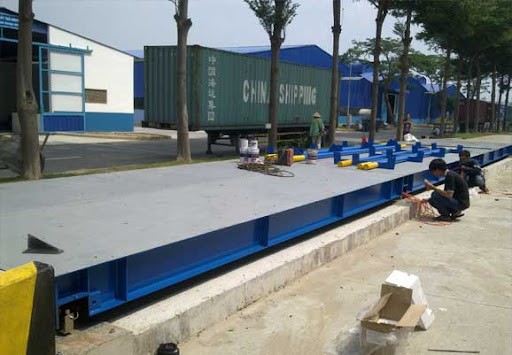Cheating at truck weigh stations is becoming an increasingly common problem, causing significant losses for businesses and affecting transportation order. Fraudulent schemes are becoming more sophisticated, requiring vehicle owners, transportation companies, and management agencies to understand them thoroughly to proactively prevent them. In this article, Xe Tải Mỹ Đình will delve into the most common methods of cheating at overloaded truck scales and propose effective countermeasures to help you protect your rights and business operations.
Common Truck Scale Cheating Methods
1. Tampering with Electronic Scale Calibration
This is a common and difficult-to-detect form of fraud, especially when the weigh station uses electronic scales. Dishonest technicians will adjust the scale’s calibration incorrectly, causing it to display a weight lower than the actual weight. This trick is often carried out by individuals with expertise in scale technology and authorized access to the system.
The advantage of this method is high accuracy in creating the desired deviation, making it difficult to detect with the naked eye. However, this cheating method is easily exposed if applied to both buying and selling transactions, as the weight difference will be easily noticeable.
Prevention methods:
- Use standard weights: Carry certified standard weights to check the accuracy of the scale before conducting transactions. If a deviation is detected, request to use another scale or refuse the transaction.
- Check with personal weight: Use your known body weight to quickly check the scale’s reliability (this method is only relatively accurate).
- Request periodic scale calibration: Ensure the weigh station has a valid calibration certificate and performs periodic calibrations as required.
2. Shimming the Weighbridge Frame – A Simple Mechanical Trick
Another sophisticated yet technically simple cheating trick is shimming the weighbridge frame. Cheaters will use shims or adjust force sensor screws or overload protection screws to create mechanical obstruction on the weighbridge. When a truck drives onto the scale, part of the load will be “suspended” and not fully exert force on the sensors, leading to a lower weight reading than the actual weight.
 Shimming the weighbridge frame is a common method of cheating at truck weigh stations
Shimming the weighbridge frame is a common method of cheating at truck weigh stations
This method is often applied when purchasing goods, helping cheaters buy goods with a larger actual quantity than recorded on the invoice. To carry out this trick, cheaters need certain knowledge of the structure and operating principles of electronic platform scales.
Prevention methods:
- Carefully observe the weighbridge: Before weighing, thoroughly check the area around and under the weighbridge to detect foreign objects or unusual shims.
- Check screws and sensors: Ensure force sensor screws and overload protection screws are not tampered with and are not touching the weighbridge frame.
- Test load beforehand: If possible, use a standard load or a known weight to test the load and check the weighing results.
- Compare multiple scales: Use at least two different weigh stations to compare results, especially when suspecting fraud.
3. Software and Ticket Fraud – Hidden in Technology
Modern weigh stations often use management software and print weigh tickets. Exploiting this loophole, weigh station managers (or colluding employees) can tamper with the software to modify the weighing results before printing tickets. The sophistication of this form depends on the cheater’s ability to access and manipulate the software system.
This form of fraud is particularly difficult to control without close supervision. Businesses buying or selling goods can easily be deceived if they only trust the weigh ticket without actual verification.
Prevention methods:
- Closely supervise the weighing process: Assign a trustworthy supervisor to be present directly at the weigh station throughout the weighing process.
- Compare displayed results and printed tickets: Require supervisors to compare the results displayed on the scale screen with the results printed on the weigh ticket to detect discrepancies.
- Use company-verified scales: Prioritize using weigh stations owned by the company or weigh stations that have been verified by state agencies and are still valid.
- Control software access: Restrict access and modification rights to the scale software, granting them only to truly trustworthy and responsible employees.
4. Attacking Scale Signals – The Most Sophisticated Cheating Method
This is the most sophisticated and difficult-to-detect form of fraud today. Cheaters use electronic devices to interfere with the signal transmission between the force sensors and the scale indicator. This device can be connected directly to the indicator, junction box, or signal cable, allowing remote adjustment of the weighing results without leaving obvious traces.
 Manipulating scale signals is the most sophisticated form of truck scale cheating
Manipulating scale signals is the most sophisticated form of truck scale cheating
With this trick, the scale still operates normally during regular checks, but when a truck is on the scale, the results can be secretly adjusted to be inaccurate. Detecting this form of fraud requires in-depth knowledge of electronic scale systems and the use of specialized testing equipment.
Prevention methods:
- Inspect the signal cable system: Regularly inspect the signal cable system, indicator, and junction box to detect any foreign devices attached.
- Use scales with anti-fraud systems: Choose electronic scales integrated with anti-fraud technology that alerts when there is interference with the system.
- Periodic inspection by specialized units: Hire professional scale verification units with experience in detecting fraud for periodic inspections and risk assessments.
- Use a reference scale: Weigh goods on your own scale before going to the transaction weigh station to have a basis for comparison and discrepancy detection.
Conclusion
Cheating at overloaded truck scales is a pressing issue, causing significant damage to businesses and society. Mastering the methods of fraud and applying a comprehensive set of preventive measures is key to protecting rights and ensuring transparent and fair transportation business operations. Xe Tải Mỹ Đình hopes this article has provided useful information to help you be more proactive in combating truck scale cheating, contributing to building a healthy and efficient transportation business environment.
